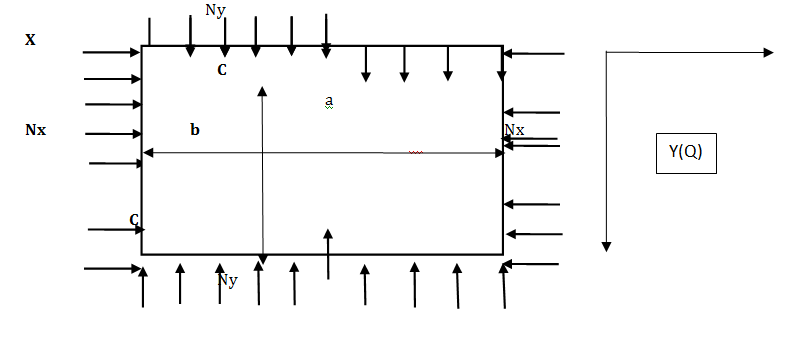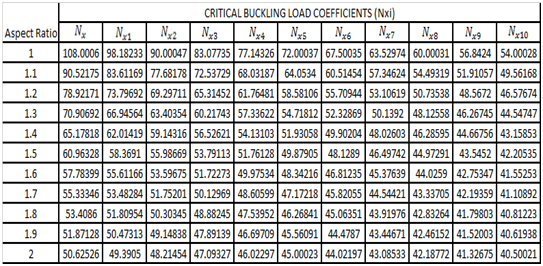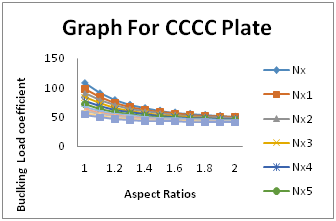Thin rectangular plates are used in the construction of thin walled structures for the transmission of both in-plane and lateral loads. The aeronautic and marine industries make particular use of such materials as thin plates. Thin plates had been defined by Szilard1 as one whose ratio of its basic dimension to its thickness falls within the range 8…10 ≤
80…100. Due to the importance and wide application of this structural material, several researches had been carried out with the aim of maximizing its potentials for wider structural applications. Areas of research of plate analysis include the vibration of plates, bending of plates and the buckling of plates. Buckling is the phenomenon in which a material under the action of in-plane compressive loads, begins to move from the state of stable equilibrium to a state of unstable equilibrium at a critical value of the compressive loads even when transverse loads are not applied. According to Ventsel & Krauthermmer2 failure of thin plate elements may be attributed to an elastic instability and not to the lack of their strength” Therefore, determination of the critical buckling loads of a plate, is essential to safe design of a plate for the intended use of the plate for any Engineering purpose within the safe load. Several works on the buckling analysis of plates had been done in the past. Makhtar et al,3 used a first order shear deformation theory to carry out the thermal buckling analysis of simply supported functionally graded plate and showed that when the plate aspect ratio,
is decreased, the critical temperature reduces and the plate becomes thinner. Chajes4 showed that the buckling load of a plate simply supported all round and uniformly compressed in one direction is given by Equation 1
While for a plate fully clamped on all sides and uniaxially loaded, the buckling load is given by Equation 2.
Singh & Chakrabarti5 developed an efficient CoFE model based on higher zigzag theory for the buckling analysis of a uniaxially loaded simply supported cross ply square plate. Jayashankarbabu et al.6 used the finite element method to obtain the elastic buckling load factor for square plates of different boundary conditions (such as, SCSC, CCCC, SSSS) containing square and circular cutouts, subjected to uniaxial compression, with the loads applied at the simply supported and at the clamped edges. Yao et al,7 proposed a new method which do not require the global stiffness matrix of the system but, reduces the system matrix order and improves the computational efficiency for analyzing plates which are simply supported on all edges. Ezeh et al.8 proposed shape functions based on the characteristic orthogonal polynomial and used them in the Galerkin’s indirect variational principle for carrying out the elastic buckling analysis of a thin plate clamped at all edges, and subjected to axial load in the x-direction. Ventsel & Krauthermmer,2 Iyengar9 & Chajes,4 individually, demonstrated that for a biaxially loaded square SSSS plates subject to uniform pressure on both sides, the critical load Ncr, is given by Equation 3.
Eqn 3
Ibearugbulem et al.10 derived a polynomial shape function and used it in the Ritz method to carry out the buckling analysis of plates with boundary conditions (such as the SSSS, CCCC, CSSS, CCSS, CSCS, and the CCCS).From available literature, it will be discovered that works on the buckling analysis of plates had revolved mostly around uniaxially loaded, and square simply supported biaxially loaded plates subject to uniform pressure. To the best of our knowledge, there is extreme dearth of literature on the buckling analysis of all-round clamped thin isotropic square and rectangular plates subject to biaxial loading. The objective of this work, is to fill the gap in literature, by providing solutions to the buckling analysis of all-round clamped thin isotropic rectangular plates subject to biaxial loading (with unequal forces in the both axes) by using the polynomial shape function proposed by Ibearugbulem11 in the Galerkin’s work method to derive the equation for buckling of plates.
The method of solution is detailed as presented in the following stages below.
Formulation of the equation of buckling of biaxially compressed thin rectangular isotropic plates
Consider a fully clamped flat isotropic plate under the action of biaxial compressive in-plane loads as shown in Figure 1. Let the thickness of the plate in the z- direction be far smaller than both the length and width of the plate in the x-and y-directions.

Figure 1 A CCCC Plate Under-going Biaxial Compression.
The overall governing differential equations for plates, is given by Ibearugbulem et al.10 as, Equation 4
Where W = AH (5)
For biaxial buckling
hence, Ventsel & Krauthammer2 gave the buckling equation as; Equation (6)
The Equation (6), is the equation of forces acting on the biaxially loaded plate. These forces (both internal and external) acting on the plate, together have the tendency to cause the plate to be deformed. If “w” is the average deformation caused on the plate by the forces, then the work done by the forces on the plates is as given by Equation (7)
The Equation (7) being Galerkin’s expression for the biaxial buckling of plates at any arbitrary point, was obtained by multiplying Equation (5) by the average deformation “w” of the plate.
The entire work done on the plate, obtained by integrating Equation (7) completely along the x-and y-axes, is given by Equation (8).
For rapid solution of the plate problem, the Cartesian coordinates, are expressed in terms of non-dimensional parameters as;
(9)
Let the aspect ratio,
be given by the Equation (10)
Substituting Equations (5), (9) and (10) into equation (8), and simplifying gives Equation (11)
Let the forces in the x- and y- axes of the plates be related by Equation 12.
Substituting Equation (12) into (11), and multiplying the resulting equation by a2, yields Equation (13)
Making
the subject of the Equation (13), gives the general equation of buckling of a biaxially compressed thin rectangular isotropic plate as Equation (14)
Taylor-McLaurin’s series formulated deflection function of the CCCC isotropic rectangular plate
Since, for an all-round clamped plate, the deflections and rotations, are zeros at all edges of the plate, the boundary conditions of the SSSS plate is as follows:
15
16
17
18
They
are the first derivatives of the deflection function, w, in the R-and Q-directions respectively.
Ibearugbulem (2011) assumed the shape function, w, to be continuous and differentiable. He expanded it in Taylor-Mclaurin series and truncated the infinite polynomial series at m = n = 4 and got the general polynomial deflection equation of rectangular plates as follows.
(19)
Where
are constants and
are as already defined earlier.
Substituting the first and second boundary conditions (i.e Equations (15) and (16)) into
Equation (19) and solving the resulting simultaneous equations, yields,
,
and
.(20)
In the same way, substituting Equations (17) and Equations (18) into Equation (19), yields,
,
and
.(21)
Substituting Equations (20) and (21) into Equation (19), gives the particular deflection equation of an all-round clamped isotropic thin rectangular plate as Equation (22)
Where,
Determination of the critical biaxial buckling loads for CCCC Plates
Differentiating Equation (24) with respect to the R-and Q-axes, gave the following results;
Integrating the derivatives of Equations (25) to (2.9) with respect to R and Q from 0-1, yields the results given as Equations (30) to (34):
=
Substituting the numerical values obtained from Equations (30) – (34) into Equation (14), gave
The Equation (35) is the expression for the critical buckling load of a biaxially loaded CCCC plate. While the Equation (36)
Is the expression for the biaxial coefficient of an all-round CCCC plate.




